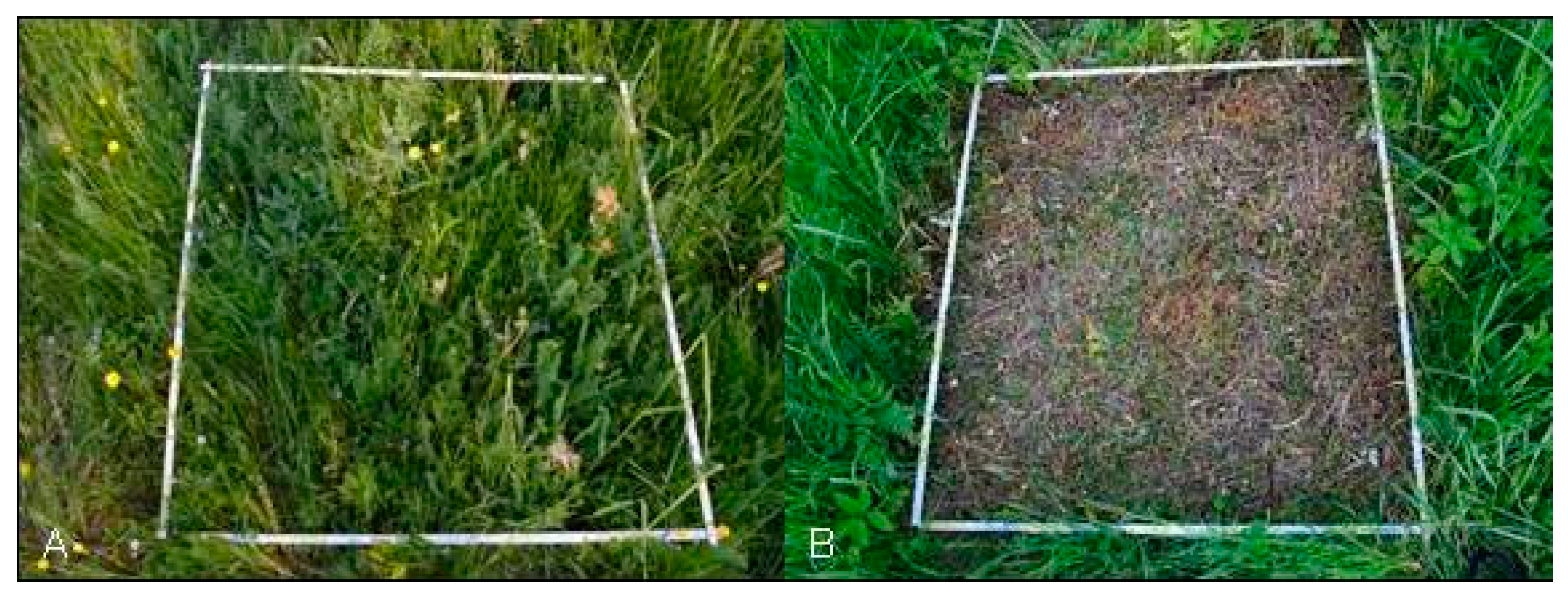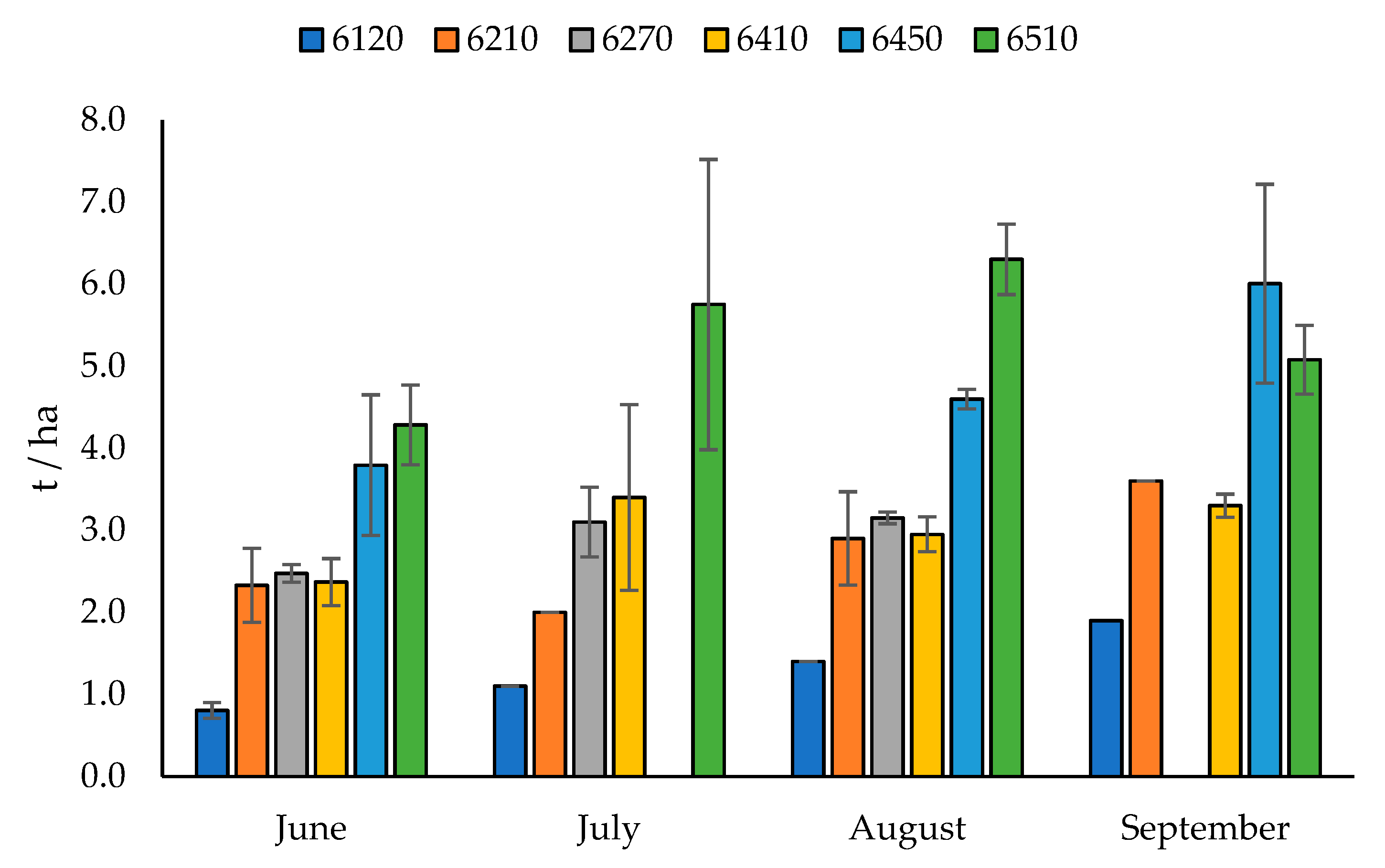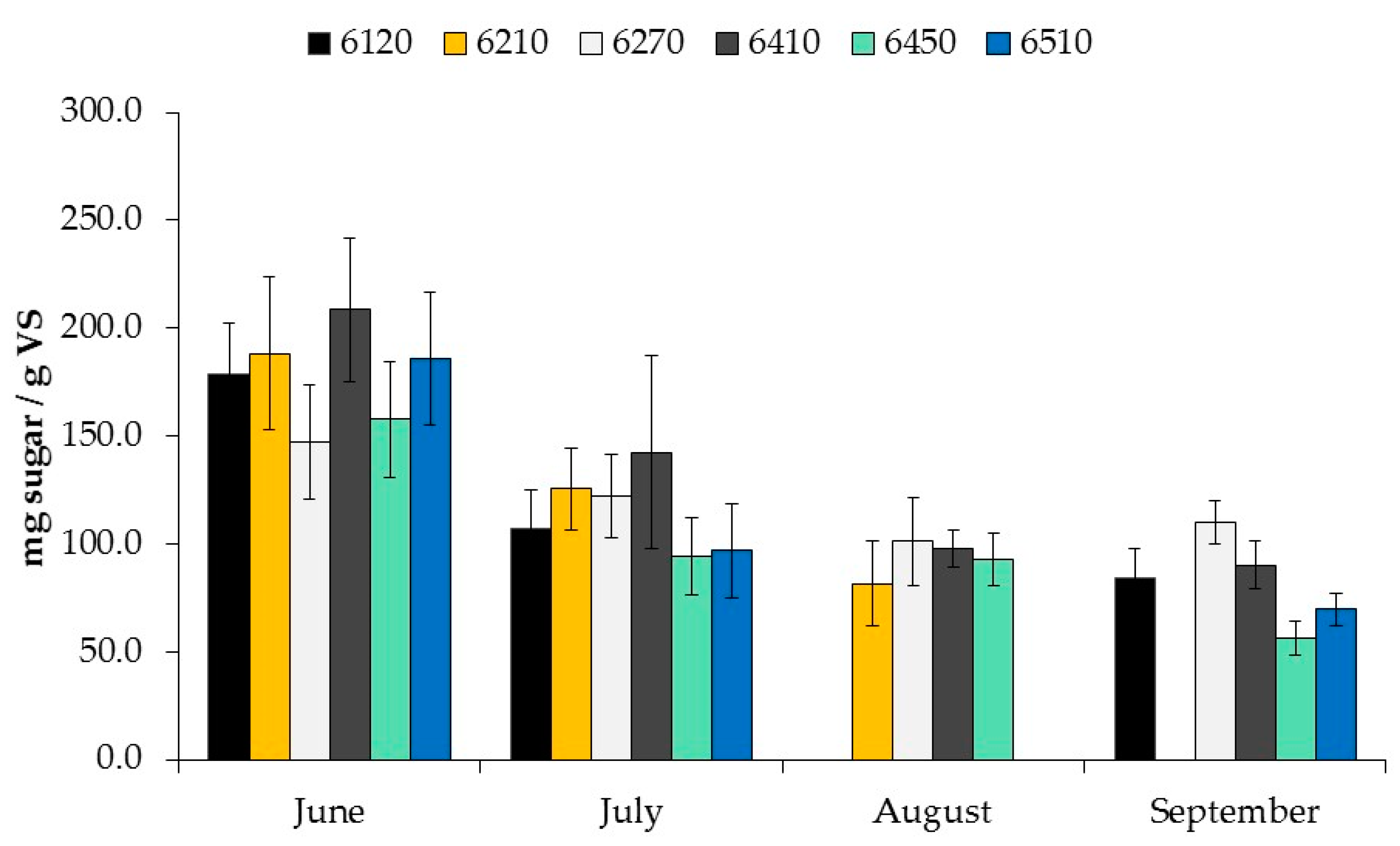Natural Grasslands as Lignocellulosic Biofuel Resources: Factors Affecting Fermentable Sugar Production
Abstract
1. Introduction
2. Materials and Methods
2.1. Biomass Sampling
2.2. Dry Matter and Ash Content Analyses
2.3. Enzymatic Hydrolysis
2.4. Reducing Sugar Analyses
2.5. Statistical Analyses
3. Results and Discussion
3.1. Assessment of Biomass Resources
3.2. Enzyme Potential to Release Carbohydrates
3.3. Fermentable Sugar Yields
4. Conclusions
Supplementary Materials
Author Contributions
Funding
Institutional Review Board Statement
Informed Consent Statement
Data Availability Statement
Acknowledgments
Conflicts of Interest
References
- European Commission; Directive (EU). 2018/2001 on the promotion of the use of energy from renewable sources. Off. J. Eur. Union 2018, 5, 82–209. [Google Scholar]
- Basile, A.; Dalena, F. Second and Third Generation of Feedstocks: The Evolution of Biofuels; Elsevier: Amsterdam, The Netherlands, 2019; pp. 213–240. [Google Scholar]
- Pandey, A.; Negi, S.; Binod, P.; Larroche, C. Pretreatment of Biomass, 1st ed.; Elsevier: Amsterdam, Netherlands, 2015; pp. 1–272. [Google Scholar]
- Jungers, J.M.; Fargione, J.E.; Sheaffer, C.C.; Wyse, D.L.; Lehman, C. Energy potential of biomass from conservation grasslands in Minnesota, USA. PLoS ONE 2013, 8, e61209. [Google Scholar] [CrossRef]
- European Commission. 15 December 2020 Eurostat. Utilized Agricultural Area by Categories. Available online: https://ec.europa.eu/eurostat/databrowser/view/tag00025/default/table?lang=en (accessed on 30 December 2020).
- Wilson, J.B.; Peet, R.K.; Dengler, J.; Partel, M. Plant species richness: The world records. J. Veg. Sci. 2012, 23, 796–802. [Google Scholar] [CrossRef]
- Isselstein, J.; Jeangros, B.; Pavlu, V. Agronomic aspects of biodiversity targeted management of temperate grasslands in Europe—A review. Agron. Res. 2005, 3, 139–151. [Google Scholar]
- Ostermann, O.P. The need for management of nature conservation sites designated under Natura 2000. J. Appl. Ecol. 1998, 35, 968–973. [Google Scholar] [CrossRef]
- European Commission. Farming for Natura 2000. Guidance on How to Support Natura 2000 Farming Systems to Achieve Conservation Objectives, Based on Member States Good Practice Experiences; Publications Office of the European Union: Luxembourg, 2018; pp. 1–146.
- Poschlod, P.; Bakker, J.P.; Kahmen, S. Changing land use and its impact on biodiversity. Basic Appl. Ecol. 2005, 6, 93–98. [Google Scholar] [CrossRef]
- Dengler, J.; Janisová, M.; Török, P.; Wellstein, C. Biodiversity of Palaearctic grasslands: A synthesis. Agric. Ecosyst. Environ. 2014, 182, 1–14. [Google Scholar] [CrossRef]
- Bobbink, R.; Den Dubbelden, K.; Willems, J.H. Seasonal dynamics of phytomass and nutrients in chalk grassland. Oikos 1989, 55, 216–224. [Google Scholar] [CrossRef]
- Spehn, E.M.; Scherer-Lorenzen, M.; Schmid, B.; Hector, A.; Caldeira, M.C.; Dimitrakopoulos, P.G.; Finn, J.A.; Jumpponen, A.; O’Donnovan, G.; Pereira, J.S.; et al. The role of legumes as a component of biodiversity in a cross European study of grassland biomass nitrogen. Oikos 2002, 98, 205–218. [Google Scholar] [CrossRef]
- Poptcheva, K.; Schwartze, P.; Vogel, A.; Kleinebecker, T.; Hölzel, N. Changes in wet meadow vegetation after 20 years of different management in a field experiment (North-West Germany). Agric. Ecosyst. Environ. 2009, 134, 108–114. [Google Scholar] [CrossRef]
- Neuenkamp, L.; Metsoja, J.-A.; Zobel, M.; Hölzel, N. Impact of management on biodiversity-biomass relations in Estonian flooded meadows. Plant Ecol. 2013, 214, 845–856. [Google Scholar] [CrossRef]
- Janišová, M.; Michalcová, D.; Bacaro, G.; Ghisla, A. Landscape effects on diversity of semi-natural grasslands. Agric. Ecosyst. Environ. 2014, 182, 47–58. [Google Scholar] [CrossRef]
- Cousins, S.A.O.; Eriksson, O. The influence of management history and habitat on plant species richness in a rural hemiboreal landscape, Sweden. Landsc. Ecol. 2002, 17, 517–529. [Google Scholar] [CrossRef]
- Caspeta, L.; Buijs, N.A.A.; Nielsen, J. The role of biofuels in the future energy supply. Energy Environ. Sci. 2013, 6, 1077–1082. [Google Scholar] [CrossRef]
- Tsapekos, P.; Khoshnevisan, B.; Alvarado-Morales, M.; Symeonidis, A.; Kougias, P.G.; Angelidaki, I. Environmental impacts of biogas production from grass: Role of co-digestion and pretreatment at harvesting time. Appl. Energy 2019, 252, 113467. [Google Scholar] [CrossRef]
- Leclere, D.; Valin, H.; Frank, S.; Havlik, P. Assessing the Land Use Change Impacts of Using EU Grassland for Biofuel Production. Task 4b of Tender ENER/C1/2013-412; ECOFYS Netherland B.V.: Utrecht, The Netherlands, 2016; pp. 1–49. [Google Scholar]
- Xu, N.; Liu, S.; Xin, F.; Zhou, J.; Jia, H.; Xu, J.; Jiang, M.; Dong, W. Biomethane production from lignocellulose: Biomass Recalcitrance and its impacts on anaerobic digestion. Front. Bioeng. Biotechnol. 2019, 7, 1–12. [Google Scholar] [CrossRef] [PubMed]
- Sawatdeenarunat, C.; Surendra, K.C.; Takara, D.; Oechsner, H.; Khanal, S.K. Anaerobic digestion of lignocellulosic biomass: Challenges and opportunities. Bioresour. Technol. 2015, 178, 178–186. [Google Scholar] [CrossRef]
- Mezule, L.; Berzina, I.; Strods, M. The impact of substrate-enzyme proportion for efficient hydrolysis of hay. Energies 2019, 12, 3526. [Google Scholar] [CrossRef]
- Anonymous. Interpretation Manual of European Union Habitats. European Commission. DG Environment. 28 April 2013. Available online: https://ec.europa.eu/environment/nature/legislation/habitatsdirective/docs/Int_Manual_EU28.pdf (accessed on 6 February 2021).
- Aunins, A.; Aunina, L.; Bambe, B.; Engele, L.; Ikauniece, S.; Kabucis, I.; Laime, B.; Larmanis, V.; Reriha, I.; Rove, I.; et al. Eiropas Savienības Aizsargājamie Biotope Latvijā. Noteikšanas Rokasgrāmata; Latvijas Dabas Fonds: Riga, Latvia, 2013; pp. 1–391. (In Latvian) [Google Scholar]
- Devillers, P.; Devillers-Terschuren, J. A classification of Palaearctic habitats. Nat. Environ. 1996, 78, 1–157. [Google Scholar]
- EN ISO 18122:2016. Solid biofuels—Determination of Ash Content; International Organization for Standardization: Geneva, Switzerland, 2015; pp. 1–6. [Google Scholar]
- Ghose, T.K. Measurement of cellulose activities. Pure Appl. Chem. 1987, 59, 257–268. [Google Scholar] [CrossRef]
- Jenkins, B.M.; Baxter, L.L.; Miles, T.R., Jr.; Miles, T.R. Combustion properties of biomass. Fuel Process. Technol. 1998, 54, 17–46. [Google Scholar] [CrossRef]
- Melts, I. Biomass from semi-natural grasslands for bioenergy. Ph.D. Thesis, Estonian University of Life Sciences, Tartu, Estonia, 2014; p. 125. [Google Scholar]
- Wachendorf, M.; Richter, F.; Fricke, T.; Graß, R.; Neff, R. Utilization of semi-natural grassland through integrated generation of solid fuel and biogas from biomass. I. Effects of hydrothermal conditioning and mechanical dehydration on mass flows of organic and mineral plant compounds, and nutrient balances. Grass Forage Sci. 2009, 64, 132–143. [Google Scholar] [CrossRef]
- Hensgen, F.; Buhle, L.; Donnison, I.; Heinsoo, K.; Watchendorf, M. Energetic conversion of European semi-natural grassland silages through the integrated generation of solid fuel and biogas from biomass: Energy yields and the fate of organic compounds. Biores. Technol. 2014, 154, 192–200. [Google Scholar] [CrossRef] [PubMed]
- Pirhofer-Walzl, K.; Søegaard, K.; Høgh-Jensen, H.; Eriksen, J.; Sanderson, M.A.; Rasmussen, J.; Rasmussen, J. Forage herbs improve mineral composition of grassland herbage. Grass Forage Sci. 2011, 66, 415–423. [Google Scholar] [CrossRef]
- Monti, A.; Di Virgilio, N.; Venturi, G. Mineral composition and ash content of six major energy crops. Biomass Bioenergy 2008, 32, 216–223. [Google Scholar] [CrossRef]
- Chen, Y.; Sharma-Shivappa, R.R.; Keshwani, D.; Chen, C. Potential of agricultural residues and hay for bioethanol production. Appl. Biochem. Biotechnol. Part A Enzyme Eng. Biotechnol. 2007, 142, 276–290. [Google Scholar] [CrossRef] [PubMed]
- Herrmann, C.; Prochnow, A.; Heiermann, M.; Idler, C. Biomass from landscape management of grassland used for biogas production: Effects of harvest date and silage additives on feedstock quality and methane yield. Grass Forage Sci. 2013, 69, 549–566. [Google Scholar] [CrossRef]
- Zoghlami, A.; Paës, G. Lignocellulosic biomass: Understanding recalcitrance and predicting hydrolysis. Front. Chem. 2019, 18, 1–11. [Google Scholar] [CrossRef]
- Prochnow, A.; Heiermann, M.; Plöchl, M.; Linke, B.; Idler, C.; Amon, T.; Hobbs, P.J. Bioenergy from permanent grassland—A review: 1. Biogas. Bioresour. Technol. 2009, 100, 4931–4944. [Google Scholar] [CrossRef]
- Calaciura, B.; Spinelli, O. Management of Natura 2000 Habitats. 6210 Semi-Natural Dry Grasslands and Scrubland Facies on Calcareous Substrates (Festuco-Brometalia). European Commission. 2008. Available online: https://ec.europa.eu/environment/nature/natura2000/management/habitats/pdf/6210_Seminatural_dry_grasslands.pdf (accessed on 16 February 2021).



| European Union (EU) Habitat Type [24] | National Variants of EU Habitat Type [25] | PAL. CLASS. [26] | Dominant Species [25] | Typical Species [25] |
|---|---|---|---|---|
| 6120 Xeric sand calcareous grasslands | 6120_2 | 34.12 | Poa angustifolia, Festuca ovina, Festuca rubra | Jasione montana, Hylotelephium spp., Pilosella officinarum, Sedum acre, Thymus spp., Veronica spicata, Viscaria vulgaris |
| 6210 Semi-natural dry grasslands and scrubland facies on calcareous substrates | 6210_2, 6210_3 | 34.31 to 34.34 | 6210_2: P. angustifolia, F. rubra, Fragaria vesca 6210_3: Helictotrichon pubescens, F. rubra, Fragaria viridis, | 6210_2: Agrimonia eupatoria, Carex caryophyllea, Centaurea scabiosa, Pimpinella saxifrage, Polygala comosa, Thymus ovatus 6210_3: Filipendula vulgaris, Medicato falcate, Plantago media, P. angustifolia, Polygala comosa, Potentilla reptans, Trifolium montanum |
| 6270 Fennoscandian lowland species-rich dry to mesic grasslands | 6270_1, 6270_3 | 35.1212, 35.1223, 38.22, 38.241 | 6270_1: Agrostis tenuis, Anthoxanthum odoratum, Briza media, Cynosurus cristatus, F. rubra 6270_3: Deschampsia caespitosa, F. rubra, Holcus lanatus | 6270_1: Alchemilla spp., Dianthus deltoids, Leontodon hispidus, Leontodon autumnalis, P. media, Plantago lanceolate, Primula veris, Prunella vulgaris, Rhinanthus minor, Trifolium repens 6270_3: Filipendula ulmaria, Galium boreale, Geum rivale, Geranium palustre, Hierochloe odorata, Lychnis flos-cuculi, Scirpus sylvaticus, Carex cespitosa, Lysmachia nummularia |
| 6410 Molinia meadows on calcareous, peaty, or clayey-silt-laden soils | 6410_4 | 37.31 | Molinia caerulea, Festuca arundinacea, Filipendula ulmaria, H. pubescens, D. caespitosa | Carex buxbaumii, Carex flacca, Carex hartmanii, Carex hostiana, Carex panice, Galium boreale, Inula salicina, Polygala amarelle, Potentilla erecta, Scorzonera humilis, Succisa pratensis |
| 6450 Northern boreal alluvial meadows | 6450_1 | - * | Carex acuta, Carex acutiformis, Carex appropinguata, Carex elata, Carex paniculata, Carex vesicaria, Calamagrostis canescens, Phalaris arundinacea | Carex rostrata, Carex vulpina, Stellaria palustris, Lathyrus palustris, Lythrum salicaria, Veronica longifolia |
| 6510 Lowland hay meadows | 6510_1 | 38.2 | Arrhenatherum elatius, Bromopsis inermis, Festuca pratensis, H. pubescens | Crepis biennis, Heracleum sibiricum, Knautia arvensis, Pastinaca sativa, Tragopogon pratensis, Campanula patula, Centaurea jacea, Carum carvi, Galium album, Lathyrus pratensis |
| Habitat Type | Average Dry Matter, t/ha | ||
|---|---|---|---|
| 2014 | 2015 | 2016 | |
| 6120 Xeric sand calcareous grasslands | 1.0 | 1.2 | 0.8 |
| 6210 Semi-natural dry grasslands and scrubland facies on calcareous substrates | 2.1 | 3.0 | 2.1 |
| 6270 Fennoscandian lowland species-rich dry to mesic grasslands | 2.8 | 3.2 | 2.6 |
| 6410 Molinia meadows on calcareous, peaty, or clayey-silt-laden soils | 3.0 | 2.9 | 2.2 |
| 6450 Northern boreal alluvial meadows | 4.5 | 5.1 | 3.5 |
| 6510 Lowland hay meadows | 4.4 | 5.7 | 3.9 |
| EU Habitat Code | 2014 | 2015 | 2016 | |||||||||||||
| June | July | August | June | July | August | September | June | |||||||||
| mg/g VS | t/ha | mg/g VS | t/ha | mg/g VS | t/ha | mg/g VS | t/ha | mg/g VS | t/ha | mg/g VS | t/ha | mg/g VS | t/ha | mg/g VS | t/ha | |
| 6120 | 147.61 ± 29.69 | 0.133 | 107.48 ± 23.29 | 0.118 | n/d | n/d | 225.46 ± 19.90 | 0.180 | n/d | n/d | n/d | n/d | 84.58 ± 13.56 | 0.161 | 233.35 ± 109.1 | 0.186 |
| 6210 | 235.49 ± 68.20 | 0.447 | 114.80 ± 24.75 | 0.230 | 81.71 ± 25.21 | 0.204 | 176.44 ± 22.80 | 0.493 | 158.00 ± 19.10 | n/d | n/d | n/d | n/d | n/d | 181.26 ± 28.61 | 0.380 |
| 6270 | n/d | n/d | 81.20 ± 24.88 | 0.227 | 101.34 ± 22.09 | 0.314 | n/d | n/d | 115.49 ± 31.47 | 0.393 | n/d | n/d | 109.87 ± 10.01 | n/d | 147.06 ± 26.92 | 0.382 |
| 6410 | n/d | n/d | 88.49 ± 13.33 | 0.265 | 103.56 ± 6.64 | 0.321 | 139.66 ± 6.40 | 0.377 | 142.48 ± 44.60 | 0.369 | 97.87 ± 11.77 | 0.274 | 90.23 ± 1.68 | 0.298 | 203.67 ± 50.59 | 0.447 |
| 6450 | 157.08 ± 46.71 | 0.659 | 94.10 ± 3.94 | 0.489 | n/d | n/d | 152.32 ± 9.38 | 0.669 | n/d | n/d | 92.84 ± 11.9 | 0.427 | 56.16 ± 18.3 | 0.337 | 161.98 ± 37.01 | 0.564 |
| 6510 | 164.74 ± 50.59 | 0.725 | 90.55 ± 25.80 | 0.498 | n/d | n/d | 166.66 ± 5.44 | 0.783 | 105.48 ± 15.17 | 0.738 | n/d | n/d | 69.71 ± 4.83 | 0.356 | 201.88 ± 36.01 | 0.784 |
Publisher’s Note: MDPI stays neutral with regard to jurisdictional claims in published maps and institutional affiliations. |
© 2021 by the authors. Licensee MDPI, Basel, Switzerland. This article is an open access article distributed under the terms and conditions of the Creative Commons Attribution (CC BY) license (http://creativecommons.org/licenses/by/4.0/).
Share and Cite
Mezule, L.; Strazdina, B.; Dalecka, B.; Skripsts, E.; Juhna, T. Natural Grasslands as Lignocellulosic Biofuel Resources: Factors Affecting Fermentable Sugar Production. Energies 2021, 14, 1312. https://doi.org/10.3390/en14051312
Mezule L, Strazdina B, Dalecka B, Skripsts E, Juhna T. Natural Grasslands as Lignocellulosic Biofuel Resources: Factors Affecting Fermentable Sugar Production. Energies. 2021; 14(5):1312. https://doi.org/10.3390/en14051312
Chicago/Turabian StyleMezule, Linda, Baiba Strazdina, Brigita Dalecka, Eriks Skripsts, and Talis Juhna. 2021. "Natural Grasslands as Lignocellulosic Biofuel Resources: Factors Affecting Fermentable Sugar Production" Energies 14, no. 5: 1312. https://doi.org/10.3390/en14051312
APA StyleMezule, L., Strazdina, B., Dalecka, B., Skripsts, E., & Juhna, T. (2021). Natural Grasslands as Lignocellulosic Biofuel Resources: Factors Affecting Fermentable Sugar Production. Energies, 14(5), 1312. https://doi.org/10.3390/en14051312








